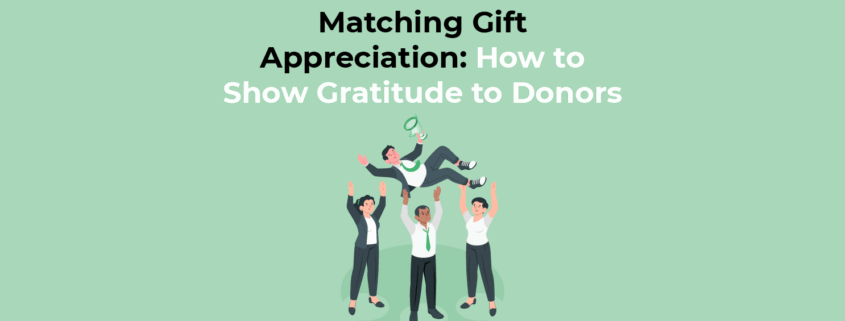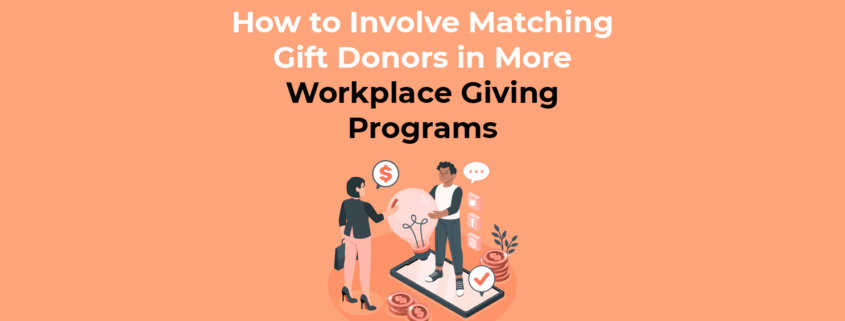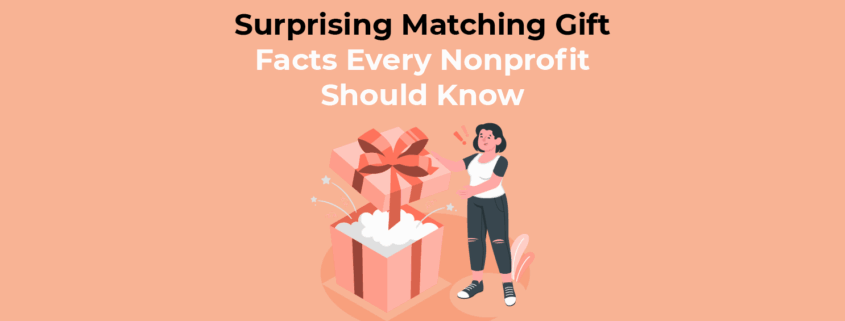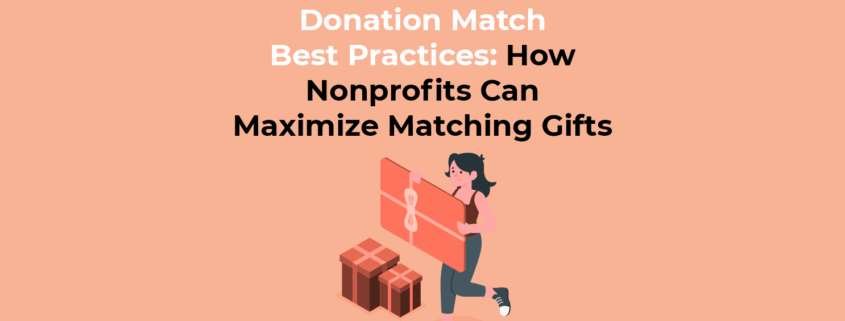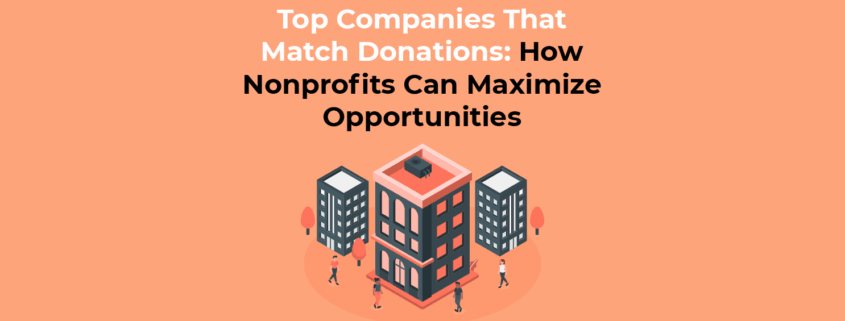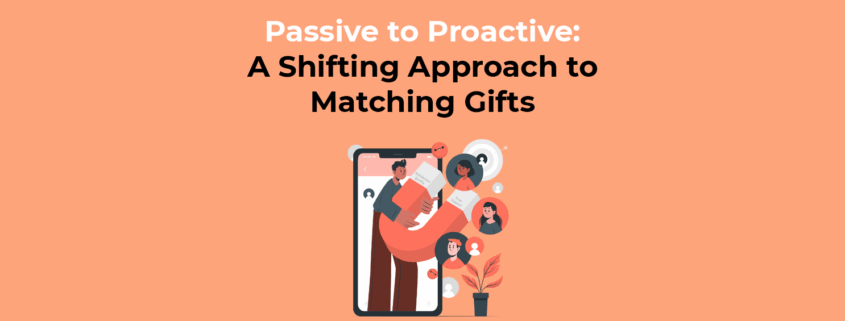Matching Gift Appreciation: How to Show Gratitude to Donors
As a nonprofit, one of the most effective ways to build a loyal and engaged donor base is by expressing appreciation for matching gifts. These gifts, where a company matches a donor’s contribution to your organization, are a key source of additional revenue. However, many nonprofits overlook the crucial step of properly thanking those who participate in the programs.
Taking the time to express gratitude can strengthen your relationships with both individual donors and corporate partners, leading to increased donations and long-term support.
In this guide, we will explore the importance of matching gift donor appreciation, the best times to express gratitude to these donors, and practical ways to do so effectively. Specifically, we’ll cover:
- Why Matching Gift Appreciation Matters
- When to Thank Matching Gift Donors
- Top Matching Gift Appreciation Ideas to Consider
- Leveraging Matching Gift Appreciation for Future Engagement
Whether you’re working with new matching gift donors or longtime workplace giving supporters, making them feel appreciated is essential to building strong, lasting relationships. Let’s begin with the basics and find out how we can do so.
Why Matching Gift Appreciation Matters
The role of appreciation in nonprofit fundraising cannot be overstated. Donors who feel appreciated are more likely to remain engaged with your cause, contribute time and again, and even encourage others to get involved. This is particularly true for matching gift donors.
Here’s why showing appreciation for matching gifts is so important:
- Showing Appreciation Strengthens Relationships: By acknowledging and thanking donors, you create a sense of partnership that helps deepen their connection to your cause. Whether you thank them after their donation, when the match is initiated, or when their employer’s donation is ultimately received, showing appreciation builds trust and loyalty.
- Showing Appreciation Increases Donor Retention: When donors feel valued, they are more likely to give again, increasing the likelihood of sustaining long-term donations. Studies show that donors who receive timely and heartfelt thank-you notes are significantly more likely to continue contributing year after year.
- Showing Appreciation Enhances Corporate Relationships: When companies recognize that their employees’ contributions are valued, they may be more likely to increase their support and participation in the future. Showing appreciation for matching gifts also creates a positive public relations opportunity for companies, leading to stronger corporate relationships and even future collaborations.
By expressing your organization’s sincere gratitude, you ensure that donors feel recognized and valued, not just for their contribution, but also for the additional impact they’re helping create through matching gifts.
When to Thank Matching Gift Donors
Timing is key when it comes to showing gratitude, especially in terms of matching gifts. To ensure your appreciation feels genuine and relevant, it’s essential to thank matching gift donors at several key moments throughout the donation process.
Here’s when we recommend showing appreciation to matching gift donors:
After the Initial Donation
The first step in thanking a matching gift donor is to acknowledge their original contribution. As soon as you receive the donation, send a thank-you message that acknowledges the donor’s generosity. This is a great opportunity to mention the potential for matching gifts and inform them about the next steps.
Ensure the message emphasizes the significance of their support and provides details on how matching gifts can help double or even triple their donation.
After They Initiate a Match
Once the donor has submitted the match request to their employer, follow up to thank them for initiating the process. This is a critical moment to let them know that you are actively tracking their gift and that you appreciate the extra effort they’re putting in to increase their impact.
A quick email or personal note acknowledging their initiative can go a long way in reinforcing the donor’s connection to your cause. You can also inform them of the next steps in the process, ensuring they are aware that you are managing the match request diligently.
After the Match is Received
The final thank-you comes when the matching gift has been confirmed and received. This is an essential moment to acknowledge the full impact of the donation, which now includes the matching gift from their employer. Not only does this thank-you message recognize the donor’s generosity, but it also shows appreciation for the company’s contribution and closes the loop in the match.
A timely, heartfelt message at this stage demonstrates to donors that you have followed through on tracking their matching gift and that their efforts have resulted in significant additional support for your cause.
Top Matching Gift Appreciation Ideas to Consider
Effective matching gift appreciation involves more than a simple thank-you. In fact, it’s really about creating personalized, thoughtful gestures that demonstrate your genuine gratitude.
Below are several ways you can show appreciation to your matching gift donors, ensuring that each donation is met with the recognition it deserves.
Personalized Thank-You Emails
One of the easiest and most effective ways to thank matching gift donors is through a personalized thank-you email. This type of email can be sent promptly after the initial donation and again after the matching gift has been initiated or received.
For the best results, these emails can include:
- A special thank you for the matching gift process.
- An update on how the matched funds will be used.
- A link to more information about the nonprofit’s programs, showing donors exactly how their contributions make a difference.
- A call to action, whether it’s encouraging further involvement or sharing the donor’s story, can help foster an ongoing relationship.
Personalized emails are a quick and effective way to express gratitude, and they can be automated (and utilize handy templates!) to streamline the process. However, personalized emails should go beyond generic messaging by addressing the donor by name and recognizing their specific employer or contribution.
Handwritten Letters
For a more personal touch, handwritten letters are an excellent way to make your appreciation feel even more heartfelt. A handwritten note stands out from the usual correspondence donors receive and can create a stronger emotional connection. While more time-consuming, sending a handwritten thank-you note after receiving a matching gift adds a special, thoughtful element to donor relations.
A physical letter can include:
- A detailed thank-you for both the original donation and the matching gift.
- A description of the impact that their gift will have on the nonprofit’s mission.
- A personal mention of the donor’s involvement with the organization (if applicable).
The tactile nature of a handwritten letter makes it stand out, providing a sense of warmth and authenticity that emails can sometimes lack. Donors receiving a handwritten letter often feel more personally connected to your cause, which leads to greater donor retention.
Phone Calls
Sometimes, a phone call is the best way to show your gratitude. A personal call to thank a matching gift donor (especially for larger contributions) can leave a lasting impression. It’s an opportunity to express your gratitude in real-time and provide a personal connection that emails or letters can’t match.
During the call, be sure to:
- Acknowledge the full value of their gift, including the matched donation.
- Explain how their contribution is making a difference.
- Let them know how much their involvement means to your nonprofit’s success.
A phone call presents a unique opportunity to convey the depth of your appreciation and foster a more personal connection. If the donor has a long history with your nonprofit, use this moment to reinforce their value and discuss the impact of their contributions over time.
Digital Greeting Cards
In today’s digital world, a digital greeting card can be a fun and engaging way to express gratitude. You can design an eye-catching, interactive digital card that includes heartfelt messaging, images, and even videos showcasing the impact of the donor’s contribution.
These can be especially useful if you have a broad donor base and want to send something special without the cost or time involved in physical mailings. Personalized messages can be included, along with a call-to-action for further involvement.
Text Messages
Sending a thank-you text message can be a quick and effective way to show appreciation for a matching gift. Texts are immediate and tend to have higher open rates than emails, making them a great way to ensure your message is seen promptly. You can send a short but sweet thank-you message once the match is confirmed, along with a reminder of how the donor’s efforts are making a significant impact.
Text messages can also include links to other engagement opportunities, such as invitations to upcoming events or direct links to your donation page for future contributions. This makes it easy for donors to continue their support with just a few clicks.
Social Media Shoutouts
Public acknowledgment is another great way to appreciate matching gift donors. Sharing a social media shoutout is an excellent way to recognize donors while also promoting corporate matching gift programs. By tagging both the donor (with their permission) and the company they work for, you can increase visibility for your supporters, strengthen your relationship, and encourage others to participate.
This is a highly visible way to show gratitude, particularly when working with corporate donors. It also encourages other employees at the company to consider engaging in matching gifts, creating a ripple effect that can lead to more support.
Recognition on Your Website
To make a lasting impression, consider recognizing matching gift donors on your website. This can be done on a dedicated donor appreciation page or virtual donor wall, or in an annual report.
Website recognition can also create a sense of community among donors. When people see their names featured on your website, it reinforces their connection with your organization and encourages them to give further.
VIP Donor Events
For your largest matching gift donors, hosting a VIP donor event (virtual or in-person) can be a great way to show appreciation. These events provide an opportunity to personally thank donors, acknowledge their contributions, and foster their ongoing engagement with your nonprofit’s work. Whether it’s a gala, a private tour, or a small, exclusive event, this gesture helps build a deeper, long-term relationship with your biggest supporters.
VIP events enable you to treat top donors with the respect they deserve, fostering a deeper connection with your cause. You can use these events to share exclusive updates on your nonprofit’s impact, furthering the donor’s sense of involvement and investment in your mission.
Leveraging Matching Gift Appreciation for Future Engagement
Proper appreciation doesn’t stop with one thank-you message. By continuing to engage matching gift donors and acknowledging their support over time, you lay the groundwork for more future donations and long-term engagement. Regular communication, updates on the impact of their contributions, and ongoing recognition can encourage donors to give again, participate in future matching gift programs, and even become advocates for your nonprofit.
Building lasting relationships through consistent appreciation ensures that matching gift donors remain excited about supporting your cause. The stronger the connection, the more likely they are to continue their contributions, resulting in larger donations and additional partnerships in the future.
Wrapping Up & Next Steps
Appreciating matching gift donors is essential for building strong, lasting relationships that drive future contributions and engagement. By thanking donors at key moments, such as after the initial donation, after they initiate the match, and after the match is received, you demonstrate the value you place on their generosity.
Whether through personalized thank-you emails, handwritten letters, or exclusive VIP events, there are numerous ways to express gratitude and foster donor loyalty. Select the ones that resonate best with your audience, and integrate them into your existing donor appreciation strategy.
